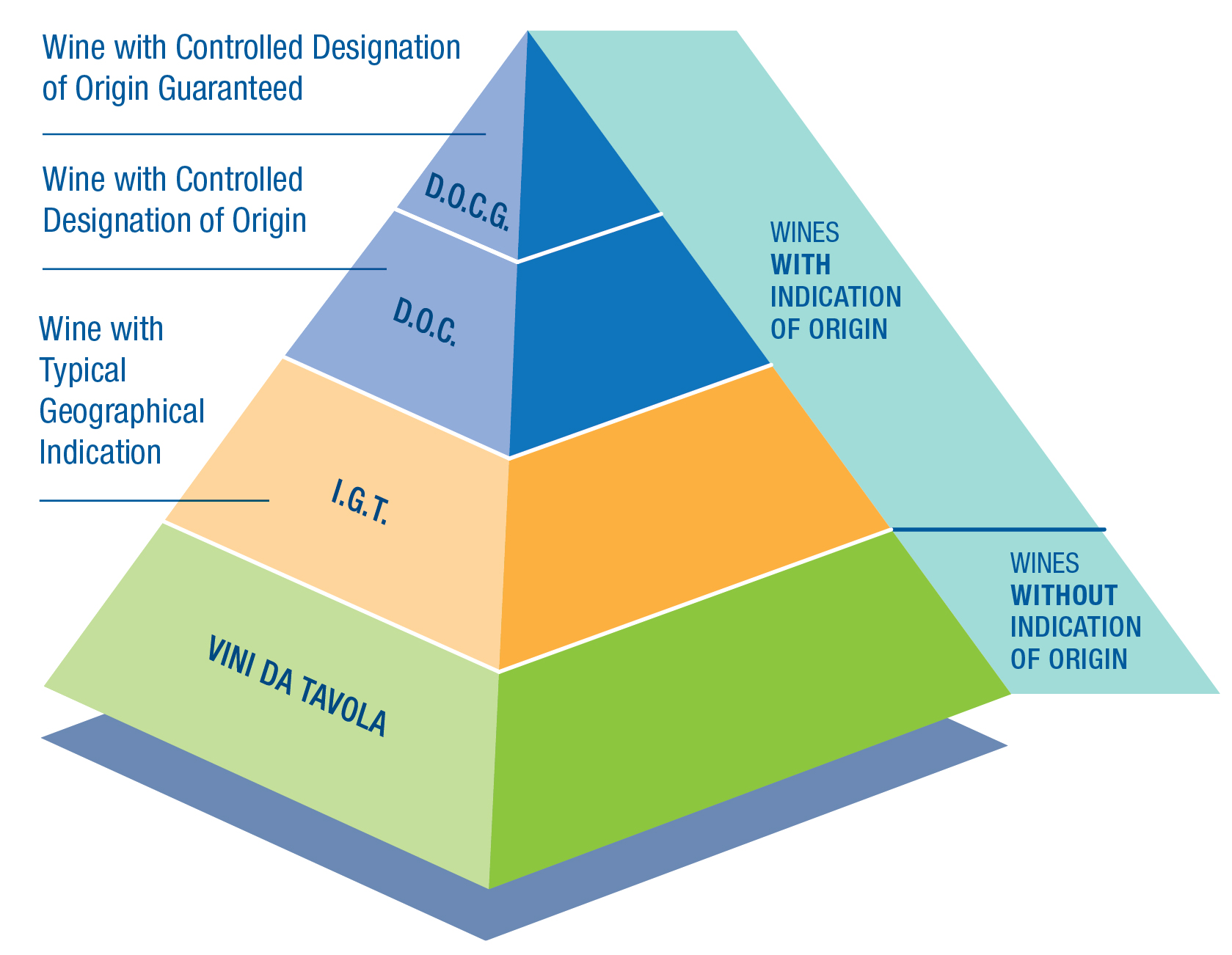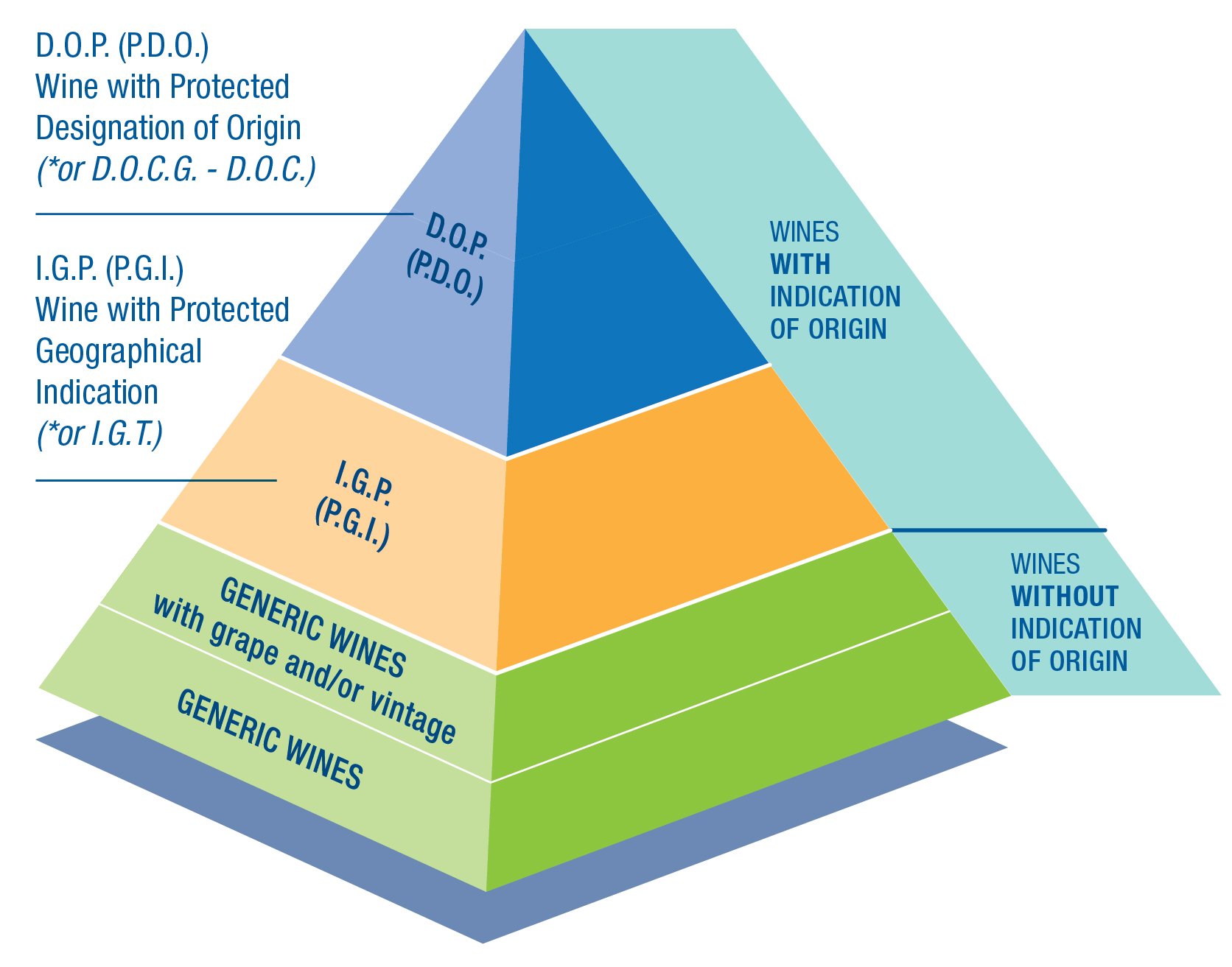
THE PYRAMID OF ITALIAN WINES
(until 2009)
“Vini da tavola”
At the base of the pyramid there are “Vini da tavola”. These are products that are produced without any reference to a territory or geographical area. These wines don’t have any specific qualitative characteristics, but it doesn’t mean that they are of low quality or that they aren’t genuine.
In addition to the denominations that derive from the color (e.g. white, red, rosé) the year of production is sometimes displayed on the label. In the absence of other specifications, it could be that it is a simple product which is the result of the union of different grape varieties or wineries from different geographical areas.
I.G.T. wines
On the second to last level of the pyramid there are the “Indicazione Geografica Tipica or I.G.T.” (Typical Geographical Indication) wines.
The main features of an I.G.T wine are the geographical area from which it originated (for example Latium or Veneto), the base grape variety (for example Chardonnay) and the vintage year. At least 85% of these wines are named after the geographical area they derived from.
Finally, I.G.T. wines must meet certain parameters that are indicated by production regulations, such as:
- the maximum yield of grapes per hectare;
- the transformation yield of grapes into wine;
- the minimum natural alcoholic proof;
- the alcoholic strength for consumption;
- the vines from which they can be obtained.
D.O.C. wines
One step higher in the pyramid we find the “Denominazione di Origine Controllata or D.O.C.” (Registered Designation of Origin) wines. They are produced in a bordered land area with precise chemical and organoleptic features, that are determined in the manufacturing rules beforehand.
These rules specify the types of wine that can be produced (such as Rosso Ri-serva, or Vendemmia Tardiva), the quantities of grapes that can be obtained per hectare of vineyards, the varieties that can be used, the yield of transformation from grapes into wine, the minimum natural alcoholic strength and consumption, and the type and duration of the aging process. Practically the entire production cycle (from the vineyard to the bottle) must respect the production rules. Unlike the previous categories D.O.C. wines are also controlled qualitatively.
Before being put on the market they must undergo chemical-physical and organoleptic analyses in order to ensure their compliance with the parameters that are set in the product description.
D.O.C.G. wines
On top of the pyramid we find the “Denominazione di Origine Controllata e Garan-tita or D.O.C.G.” (Denomination of Controlled and Guaranteed Origin) wines. The naming D.O.C.G. is reserved for wines of great value, with high intrinsic qualities, that are also defined by natural, human, and historical factors that have gained commercial value and acclaim both nationally and internationally.
These wines are subjected to stricter production guidelines and have more re-strictive production regulations than D.O.C. wines. Before being recognized as D.O.C.G. these wines should have been among D.O.C. wines for at least seven years. The law also establishes that the product cannot be distributed if it exceeds the maximum capacity of six liter containers. Each bottle must also be equipped with a label bearing an alphanumeric code that is issued by the state. This label is assigned to the bottlers and must be applied on every single bottle produced.

THE NEW PYRAMID OF ITALIAN WINES
(FROM AUGUST 1ST, 2009)
Generic wines (with the possibility of indicating vintage and/or grape)
These are wines with no origin indication that can be produced with grapes from different areas and/or from different Member States.
Their label they can show a reference to the vintage and/or the variety of grapes used. The indication on the label of the vine is limited to only a few varieties: Cabernet, Cabernet
Franc, Cabernet Sauvignon, Chardonnay, Merlot, Sauvignon, Syrah.
I.G.P. (P.G.I.) Protected Geographical Indication
It indicates the name used to designate a product originating in a specific place, region or, in exceptional cases, a country, for which a certain quality, reputation or other characteristics are attributable to its geographical origin. At least 85% of the grapes that are used to make these wines come from this geographical area.
For PGI 85% of the grapes must originate solely from the limited territory and the production of the wine takes place esclusively in that area.
In addition, PGI wines are obtained from vine varieties belonging to Vitis vinifera or a cross between the Vitis vinifera species and other species of the genus Vitis.
D.O.P. (P.D.O.) Protected Designation Of Origin
It indicates the name used to designate a product which is originating in a specific place, region or, in exceptional cases, country, for which its quality or characteristics are essentially or exclusively due to its origin.
Natural and human factors of the territory are often responsible for that differentiated quality. For a PDO, 100% of the grapes must originate solely from the limited territory and the production of the wine takes place esclusively in that territory.
In addition, PDO wines are obtained from vine varieties belonging to Vitis vinifera or a cross between the Vitis vinifera species and other species of the genus Vitis.
Member States may continue to use their «Traditional terms» that refer to Designation of Origin or Geographical Indication.
Italy may continue to use its Traditional terms: DOCG, DOC, IGT.
